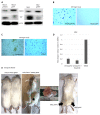Transposon Mutagenesis-Guided CRISPR/Cas9 Screening Strongly Implicates Dysregulation of Hippo/YAP Signaling in Malignant Peripheral Nerve Sheath Tumor Development
- PMID: 33808166
- PMCID: PMC8038069
- DOI: 10.3390/cancers13071584
Transposon Mutagenesis-Guided CRISPR/Cas9 Screening Strongly Implicates Dysregulation of Hippo/YAP Signaling in Malignant Peripheral Nerve Sheath Tumor Development
Abstract
Malignant peripheral nerve sheath tumors (MPNSTs) are highly aggressive, genomically complex, have soft tissue sarcomas, and are derived from the Schwann cell lineage. Patients with neurofibromatosis type 1 syndrome (NF1), an autosomal dominant tumor predisposition syndrome, are at a high risk for MPNSTs, which usually develop from pre-existing benign Schwann cell tumors called plexiform neurofibromas. NF1 is characterized by loss-of-function mutations in the NF1 gene, which encode neurofibromin, a Ras GTPase activating protein (GAP) and negative regulator of RasGTP-dependent signaling. In addition to bi-allelic loss of NF1, other known tumor suppressor genes include TP53, CDKN2A, SUZ12, and EED, all of which are often inactivated in the process of MPNST growth. A sleeping beauty (SB) transposon-based genetic screen for high-grade Schwann cell tumors in mice, and comparative genomics, implicated Wnt/β-catenin, PI3K-AKT-mTOR, and other pathways in MPNST development and progression. We endeavored to more systematically test genes and pathways implicated by our SB screen in mice, i.e., in a human immortalized Schwann cell-based model and a human MPNST cell line, using CRISPR/Cas9 technology. We individually induced loss-of-function mutations in 103 tumor suppressor genes (TSG) and oncogene candidates. We assessed anchorage-independent growth, transwell migration, and for a subset of genes, tumor formation in vivo. When tested in a loss-of-function fashion, about 60% of all TSG candidates resulted in the transformation of immortalized human Schwann cells, whereas 30% of oncogene candidates resulted in growth arrest in a MPNST cell line. Individual loss-of-function mutations in the TAOK1, GDI2, NF1, and APC genes resulted in transformation of immortalized human Schwann cells and tumor formation in a xenograft model. Moreover, the loss of all four of these genes resulted in activation of Hippo/Yes Activated Protein (YAP) signaling. By combining SB transposon mutagenesis and CRISPR/Cas9 screening, we established a useful pipeline for the validation of MPNST pathways and genes. Our results suggest that the functional genetic landscape of human MPNST is complex and implicate the Hippo/YAP pathway in the transformation of neurofibromas. It is thus imperative to functionally validate individual cancer genes and pathways using human cell-based models, to determinate their role in different stages of MPNST development, growth, and/or metastasis.
Keywords: cancer biology; genetic screen; neurofibromatosis Type 1.
Conflict of interest statement
Largaespada is the co-founder and co-owner of several biotechnology companies including NeoClone Biotechnologies, Inc., Discovery Genomics, Inc. (recently acquired by Immunsoft, Inc.), B-MoGen Biotechnologies, Inc. (recently acquired by Biotechne corporation), and Luminary Therapeutics, Inc. He consults for Genentech, Inc., which funds some of his research. Largaespada holds equity in Recombinetics, a genome-editing company, and serves on the board of directors. The business of all these companies is unrelated to the contents of this manuscript. Ratner consults for Boehringer Ingelheim and Revolution Medicines, which is funding some of her research, unrelated to this manuscript. The other authors have no conflict of interest to disclose.
Figures




Similar articles
-
New Model Systems and the Development of Targeted Therapies for the Treatment of Neurofibromatosis Type 1-Associated Malignant Peripheral Nerve Sheath Tumors.Genes (Basel). 2020 Apr 28;11(5):477. doi: 10.3390/genes11050477. Genes (Basel). 2020. PMID: 32353955 Free PMC article. Review.
-
Confirmation of mutation landscape of NF1-associated malignant peripheral nerve sheath tumors.Genes Chromosomes Cancer. 2017 May;56(5):421-426. doi: 10.1002/gcc.22446. Epub 2017 Mar 7. Genes Chromosomes Cancer. 2017. PMID: 28124441
-
NF1 deficiency causes Bcl-xL upregulation in Schwann cells derived from neurofibromatosis type 1-associated malignant peripheral nerve sheath tumors.Int J Oncol. 2013 Feb;42(2):657-66. doi: 10.3892/ijo.2012.1751. Epub 2012 Dec 24. Int J Oncol. 2013. PMID: 23292448
-
Interferon-Induced Transmembrane Protein 1 (IFITM1) Is Downregulated in Neurofibromatosis Type 1-Associated Malignant Peripheral Nerve Sheath Tumors.Int J Mol Sci. 2024 Aug 27;25(17):9265. doi: 10.3390/ijms25179265. Int J Mol Sci. 2024. PMID: 39273214 Free PMC article.
-
Molecular targets for NF1-associated malignant peripheral nerve sheath tumor.Rep Pract Oncol Radiother. 2020 Jul-Aug;25(4):556-561. doi: 10.1016/j.rpor.2020.04.010. Epub 2020 Apr 27. Rep Pract Oncol Radiother. 2020. PMID: 32494228 Free PMC article. Review.
Cited by
-
Toward Understanding the Mechanisms of Malignant Peripheral Nerve Sheath Tumor Development.Int J Mol Sci. 2021 Aug 10;22(16):8620. doi: 10.3390/ijms22168620. Int J Mol Sci. 2021. PMID: 34445326 Free PMC article. Review.
-
Ex vivo to in vivo model of malignant peripheral nerve sheath tumors for precision oncology.Neuro Oncol. 2023 Nov 2;25(11):2044-2057. doi: 10.1093/neuonc/noad097. Neuro Oncol. 2023. PMID: 37246765 Free PMC article.
-
Biomarker Landscape in RASopathies.Int J Mol Sci. 2024 Aug 6;25(16):8563. doi: 10.3390/ijms25168563. Int J Mol Sci. 2024. PMID: 39201250 Free PMC article. Review.
-
Oncogenic RABL6A promotes NF1-associated MPNST progression in vivo.Neurooncol Adv. 2022 Apr 9;4(1):vdac047. doi: 10.1093/noajnl/vdac047. eCollection 2022 Jan-Dec. Neurooncol Adv. 2022. PMID: 35571990 Free PMC article.
-
FOXM1, MEK, and CDK4/6: New Targets for Malignant Peripheral Nerve Sheath Tumor Therapy.Int J Mol Sci. 2023 Sep 2;24(17):13596. doi: 10.3390/ijms241713596. Int J Mol Sci. 2023. PMID: 37686402 Free PMC article. Review.
References
-
- Goertz O., Langer S., Uthoff D., Ring A., Stricker I., Tannapfel A., Steinau H.-U. Diagnosis, treatment and survival of 65 patients with malignant peripheral nerve sheath tumors. Anticancer Res. 2014;34:777–783. - PubMed
-
- Watson A.L., Rahrmann E.P., Moriarity B.S., Choi K., Conboy C.B., Greeley A.D., Halfond A.L., Anderson L.K., Wahl B.R., Keng V.W., et al. Canonical Wnt/β-catenin Signaling Drives Human Schwann Cell Transformation, Progression, and Tumor Maintenance. Cancer Discov. 2013;3:674–689. doi: 10.1158/2159-8290.CD-13-0081. - DOI - PMC - PubMed
Grants and funding
LinkOut - more resources
Full Text Sources
Other Literature Sources
Research Materials
Miscellaneous

